HEA 561 - Critical Analysis of Clinical Guidelines & NSW Guardianship
VerifiedAdded on 2023/06/14
|16
|4645
|407
Essay
AI Summary
This essay provides a critical analysis of clinical guidelines, examining their benefits and limitations within the healthcare industry. It emphasizes the importance of these guidelines in standardizing care, improving patient outcomes, and promoting consistency, while also acknowledging potential drawbacks such as inflexibility, lack of rationale, and the risk of flawed practices. The essay further delves into a specific case, analyzing the guardianship application process for adult inpatients in New South Wales, Australia, assessing its evidence base, transparency, and adherence to established protocols. The analysis evaluates the guideline's objectives, definitions, and descriptions of key terms, as well as its description of the legal and legislative structure that defines the capacity of the government healthcare workforce and the principles of the Guardianship Act of 1987, ultimately providing a comprehensive understanding of the strengths and weaknesses of clinical guidelines in practice.
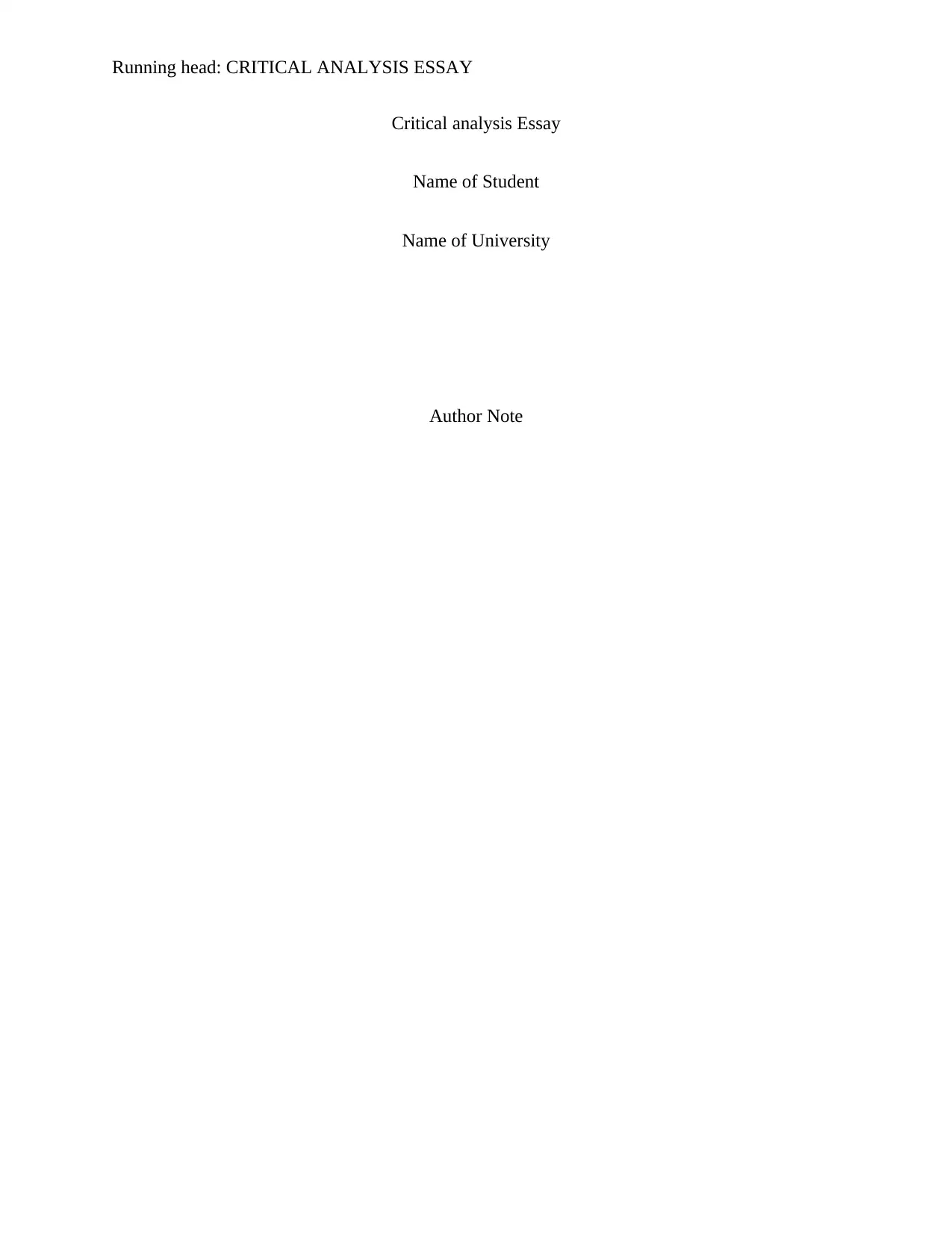
Running head: CRITICAL ANALYSIS ESSAY
Critical analysis Essay
Name of Student
Name of University
Author Note
Critical analysis Essay
Name of Student
Name of University
Author Note
Paraphrase This Document
Need a fresh take? Get an instant paraphrase of this document with our AI Paraphraser
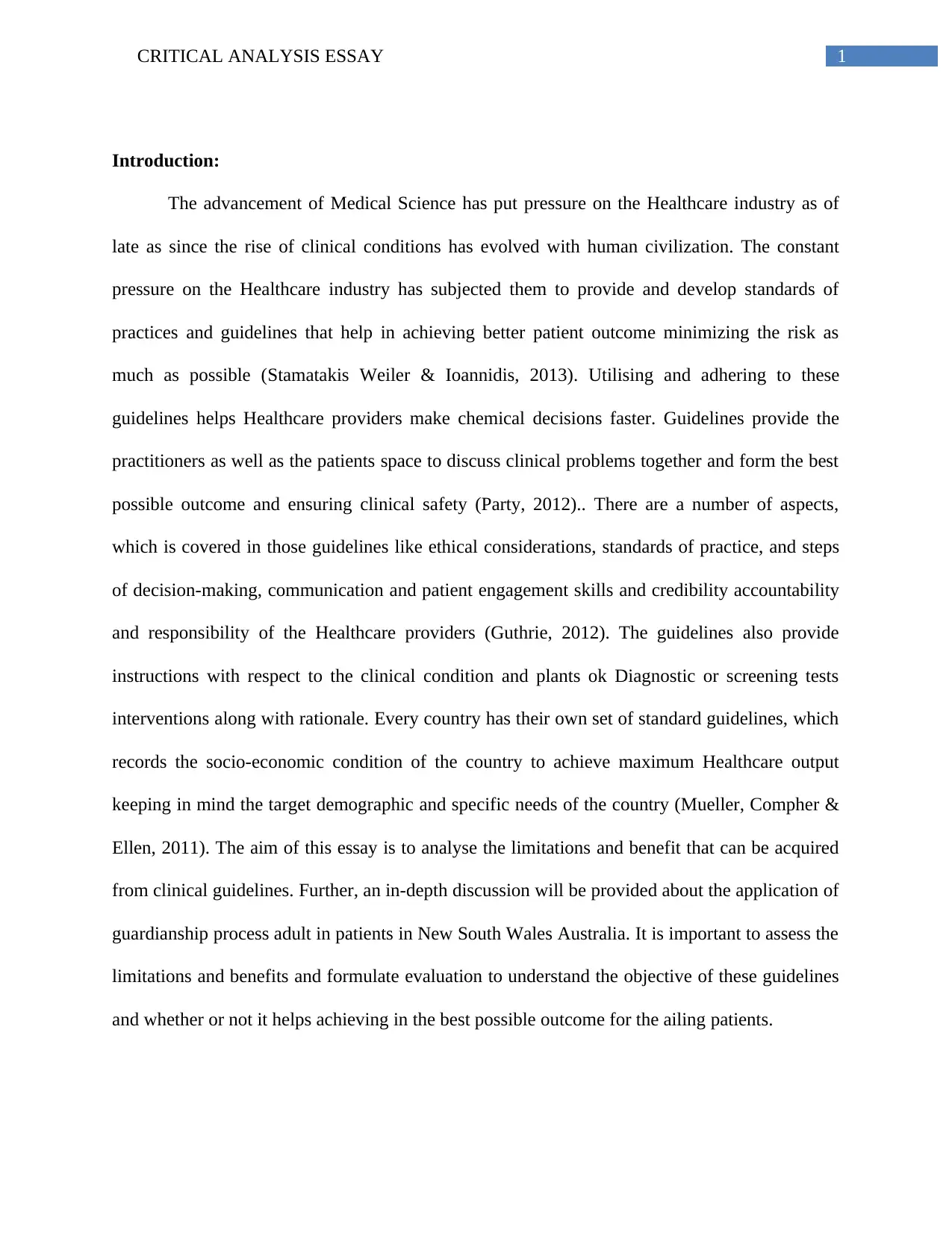
1CRITICAL ANALYSIS ESSAY
Introduction:
The advancement of Medical Science has put pressure on the Healthcare industry as of
late as since the rise of clinical conditions has evolved with human civilization. The constant
pressure on the Healthcare industry has subjected them to provide and develop standards of
practices and guidelines that help in achieving better patient outcome minimizing the risk as
much as possible (Stamatakis Weiler & Ioannidis, 2013). Utilising and adhering to these
guidelines helps Healthcare providers make chemical decisions faster. Guidelines provide the
practitioners as well as the patients space to discuss clinical problems together and form the best
possible outcome and ensuring clinical safety (Party, 2012).. There are a number of aspects,
which is covered in those guidelines like ethical considerations, standards of practice, and steps
of decision-making, communication and patient engagement skills and credibility accountability
and responsibility of the Healthcare providers (Guthrie, 2012). The guidelines also provide
instructions with respect to the clinical condition and plants ok Diagnostic or screening tests
interventions along with rationale. Every country has their own set of standard guidelines, which
records the socio-economic condition of the country to achieve maximum Healthcare output
keeping in mind the target demographic and specific needs of the country (Mueller, Compher &
Ellen, 2011). The aim of this essay is to analyse the limitations and benefit that can be acquired
from clinical guidelines. Further, an in-depth discussion will be provided about the application of
guardianship process adult in patients in New South Wales Australia. It is important to assess the
limitations and benefits and formulate evaluation to understand the objective of these guidelines
and whether or not it helps achieving in the best possible outcome for the ailing patients.
Introduction:
The advancement of Medical Science has put pressure on the Healthcare industry as of
late as since the rise of clinical conditions has evolved with human civilization. The constant
pressure on the Healthcare industry has subjected them to provide and develop standards of
practices and guidelines that help in achieving better patient outcome minimizing the risk as
much as possible (Stamatakis Weiler & Ioannidis, 2013). Utilising and adhering to these
guidelines helps Healthcare providers make chemical decisions faster. Guidelines provide the
practitioners as well as the patients space to discuss clinical problems together and form the best
possible outcome and ensuring clinical safety (Party, 2012).. There are a number of aspects,
which is covered in those guidelines like ethical considerations, standards of practice, and steps
of decision-making, communication and patient engagement skills and credibility accountability
and responsibility of the Healthcare providers (Guthrie, 2012). The guidelines also provide
instructions with respect to the clinical condition and plants ok Diagnostic or screening tests
interventions along with rationale. Every country has their own set of standard guidelines, which
records the socio-economic condition of the country to achieve maximum Healthcare output
keeping in mind the target demographic and specific needs of the country (Mueller, Compher &
Ellen, 2011). The aim of this essay is to analyse the limitations and benefit that can be acquired
from clinical guidelines. Further, an in-depth discussion will be provided about the application of
guardianship process adult in patients in New South Wales Australia. It is important to assess the
limitations and benefits and formulate evaluation to understand the objective of these guidelines
and whether or not it helps achieving in the best possible outcome for the ailing patients.
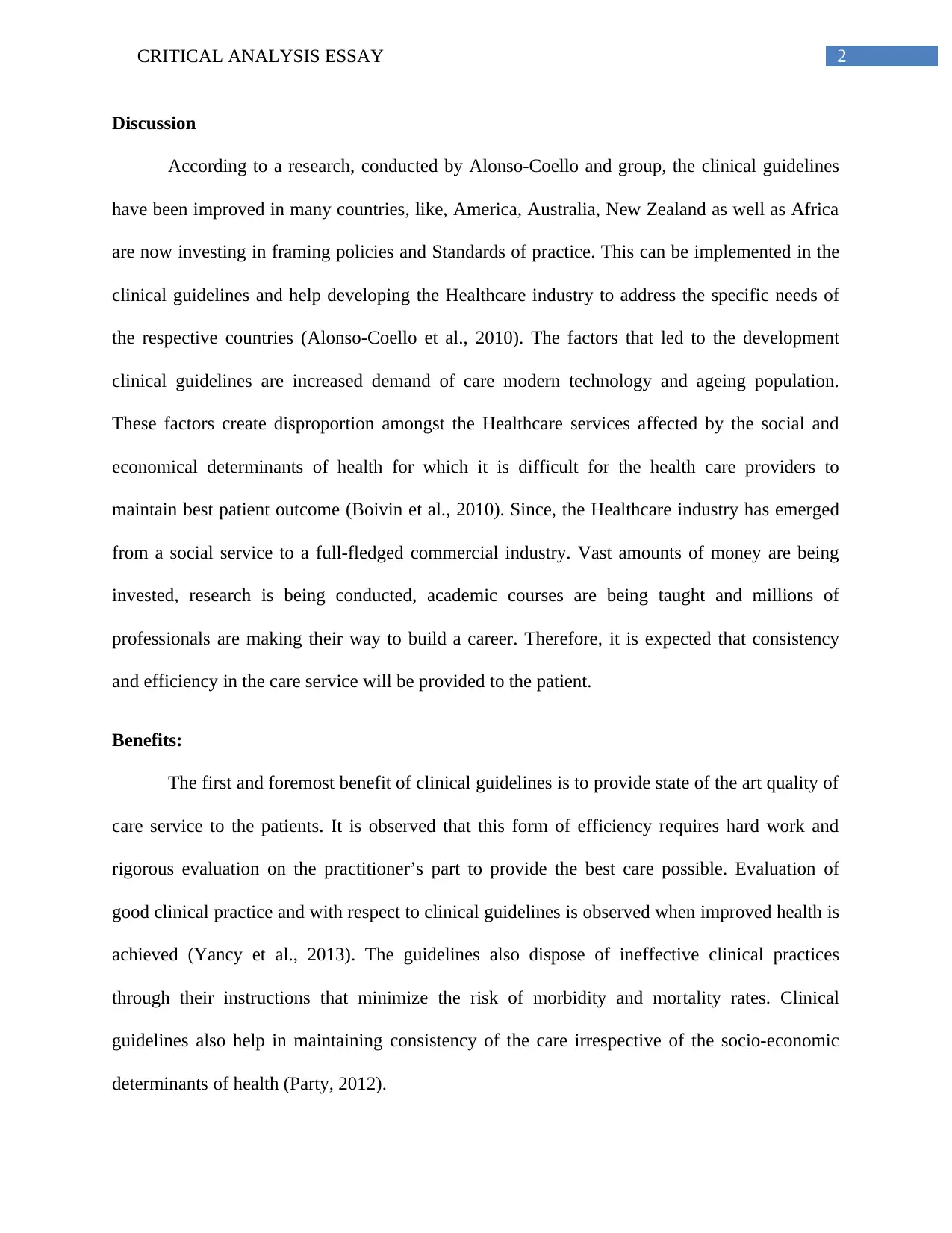
2CRITICAL ANALYSIS ESSAY
Discussion
According to a research, conducted by Alonso-Coello and group, the clinical guidelines
have been improved in many countries, like, America, Australia, New Zealand as well as Africa
are now investing in framing policies and Standards of practice. This can be implemented in the
clinical guidelines and help developing the Healthcare industry to address the specific needs of
the respective countries (Alonso-Coello et al., 2010). The factors that led to the development
clinical guidelines are increased demand of care modern technology and ageing population.
These factors create disproportion amongst the Healthcare services affected by the social and
economical determinants of health for which it is difficult for the health care providers to
maintain best patient outcome (Boivin et al., 2010). Since, the Healthcare industry has emerged
from a social service to a full-fledged commercial industry. Vast amounts of money are being
invested, research is being conducted, academic courses are being taught and millions of
professionals are making their way to build a career. Therefore, it is expected that consistency
and efficiency in the care service will be provided to the patient.
Benefits:
The first and foremost benefit of clinical guidelines is to provide state of the art quality of
care service to the patients. It is observed that this form of efficiency requires hard work and
rigorous evaluation on the practitioner’s part to provide the best care possible. Evaluation of
good clinical practice and with respect to clinical guidelines is observed when improved health is
achieved (Yancy et al., 2013). The guidelines also dispose of ineffective clinical practices
through their instructions that minimize the risk of morbidity and mortality rates. Clinical
guidelines also help in maintaining consistency of the care irrespective of the socio-economic
determinants of health (Party, 2012).
Discussion
According to a research, conducted by Alonso-Coello and group, the clinical guidelines
have been improved in many countries, like, America, Australia, New Zealand as well as Africa
are now investing in framing policies and Standards of practice. This can be implemented in the
clinical guidelines and help developing the Healthcare industry to address the specific needs of
the respective countries (Alonso-Coello et al., 2010). The factors that led to the development
clinical guidelines are increased demand of care modern technology and ageing population.
These factors create disproportion amongst the Healthcare services affected by the social and
economical determinants of health for which it is difficult for the health care providers to
maintain best patient outcome (Boivin et al., 2010). Since, the Healthcare industry has emerged
from a social service to a full-fledged commercial industry. Vast amounts of money are being
invested, research is being conducted, academic courses are being taught and millions of
professionals are making their way to build a career. Therefore, it is expected that consistency
and efficiency in the care service will be provided to the patient.
Benefits:
The first and foremost benefit of clinical guidelines is to provide state of the art quality of
care service to the patients. It is observed that this form of efficiency requires hard work and
rigorous evaluation on the practitioner’s part to provide the best care possible. Evaluation of
good clinical practice and with respect to clinical guidelines is observed when improved health is
achieved (Yancy et al., 2013). The guidelines also dispose of ineffective clinical practices
through their instructions that minimize the risk of morbidity and mortality rates. Clinical
guidelines also help in maintaining consistency of the care irrespective of the socio-economic
determinants of health (Party, 2012).
⊘ This is a preview!⊘
Do you want full access?
Subscribe today to unlock all pages.

Trusted by 1+ million students worldwide
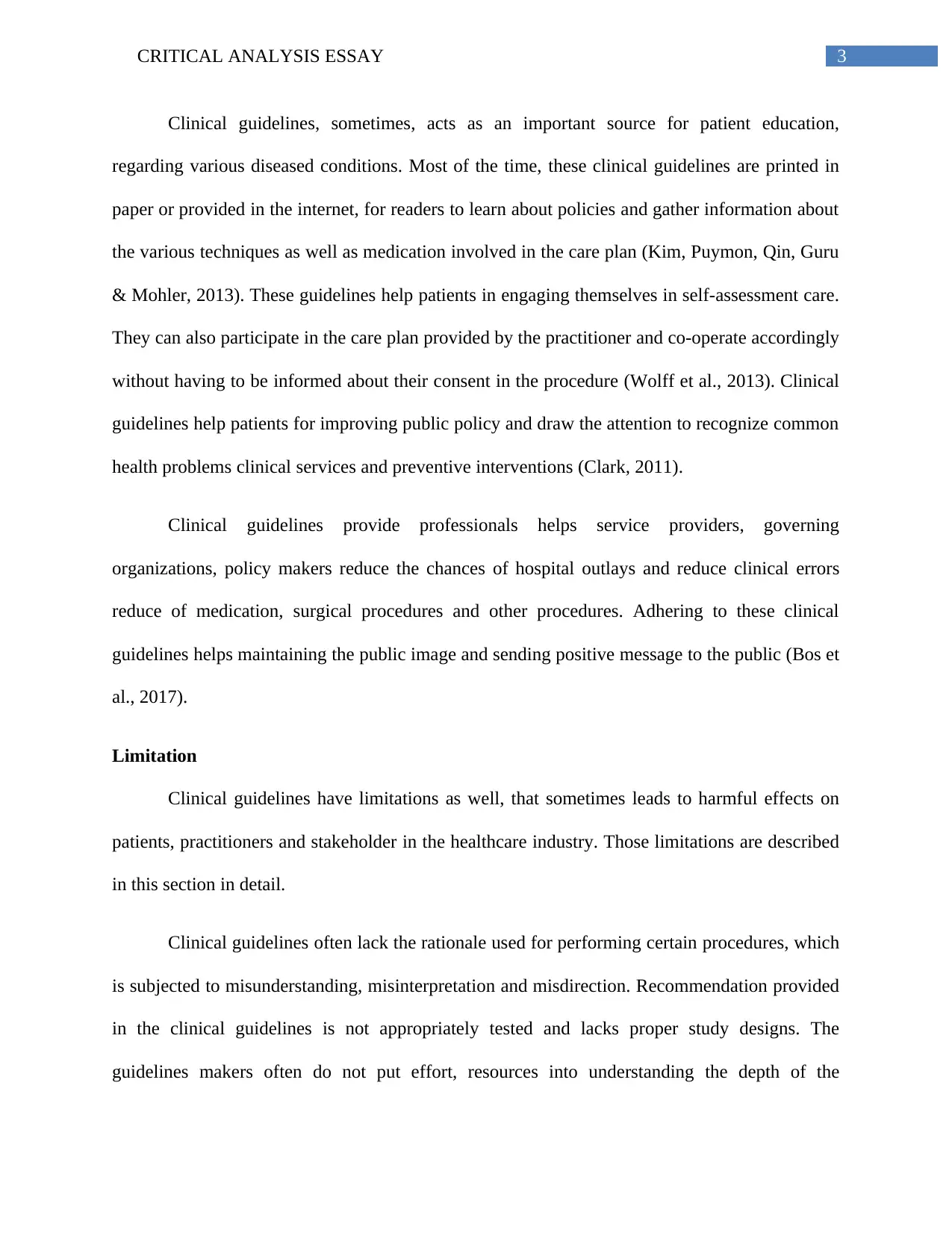
3CRITICAL ANALYSIS ESSAY
Clinical guidelines, sometimes, acts as an important source for patient education,
regarding various diseased conditions. Most of the time, these clinical guidelines are printed in
paper or provided in the internet, for readers to learn about policies and gather information about
the various techniques as well as medication involved in the care plan (Kim, Puymon, Qin, Guru
& Mohler, 2013). These guidelines help patients in engaging themselves in self-assessment care.
They can also participate in the care plan provided by the practitioner and co-operate accordingly
without having to be informed about their consent in the procedure (Wolff et al., 2013). Clinical
guidelines help patients for improving public policy and draw the attention to recognize common
health problems clinical services and preventive interventions (Clark, 2011).
Clinical guidelines provide professionals helps service providers, governing
organizations, policy makers reduce the chances of hospital outlays and reduce clinical errors
reduce of medication, surgical procedures and other procedures. Adhering to these clinical
guidelines helps maintaining the public image and sending positive message to the public (Bos et
al., 2017).
Limitation
Clinical guidelines have limitations as well, that sometimes leads to harmful effects on
patients, practitioners and stakeholder in the healthcare industry. Those limitations are described
in this section in detail.
Clinical guidelines often lack the rationale used for performing certain procedures, which
is subjected to misunderstanding, misinterpretation and misdirection. Recommendation provided
in the clinical guidelines is not appropriately tested and lacks proper study designs. The
guidelines makers often do not put effort, resources into understanding the depth of the
Clinical guidelines, sometimes, acts as an important source for patient education,
regarding various diseased conditions. Most of the time, these clinical guidelines are printed in
paper or provided in the internet, for readers to learn about policies and gather information about
the various techniques as well as medication involved in the care plan (Kim, Puymon, Qin, Guru
& Mohler, 2013). These guidelines help patients in engaging themselves in self-assessment care.
They can also participate in the care plan provided by the practitioner and co-operate accordingly
without having to be informed about their consent in the procedure (Wolff et al., 2013). Clinical
guidelines help patients for improving public policy and draw the attention to recognize common
health problems clinical services and preventive interventions (Clark, 2011).
Clinical guidelines provide professionals helps service providers, governing
organizations, policy makers reduce the chances of hospital outlays and reduce clinical errors
reduce of medication, surgical procedures and other procedures. Adhering to these clinical
guidelines helps maintaining the public image and sending positive message to the public (Bos et
al., 2017).
Limitation
Clinical guidelines have limitations as well, that sometimes leads to harmful effects on
patients, practitioners and stakeholder in the healthcare industry. Those limitations are described
in this section in detail.
Clinical guidelines often lack the rationale used for performing certain procedures, which
is subjected to misunderstanding, misinterpretation and misdirection. Recommendation provided
in the clinical guidelines is not appropriately tested and lacks proper study designs. The
guidelines makers often do not put effort, resources into understanding the depth of the
Paraphrase This Document
Need a fresh take? Get an instant paraphrase of this document with our AI Paraphraser
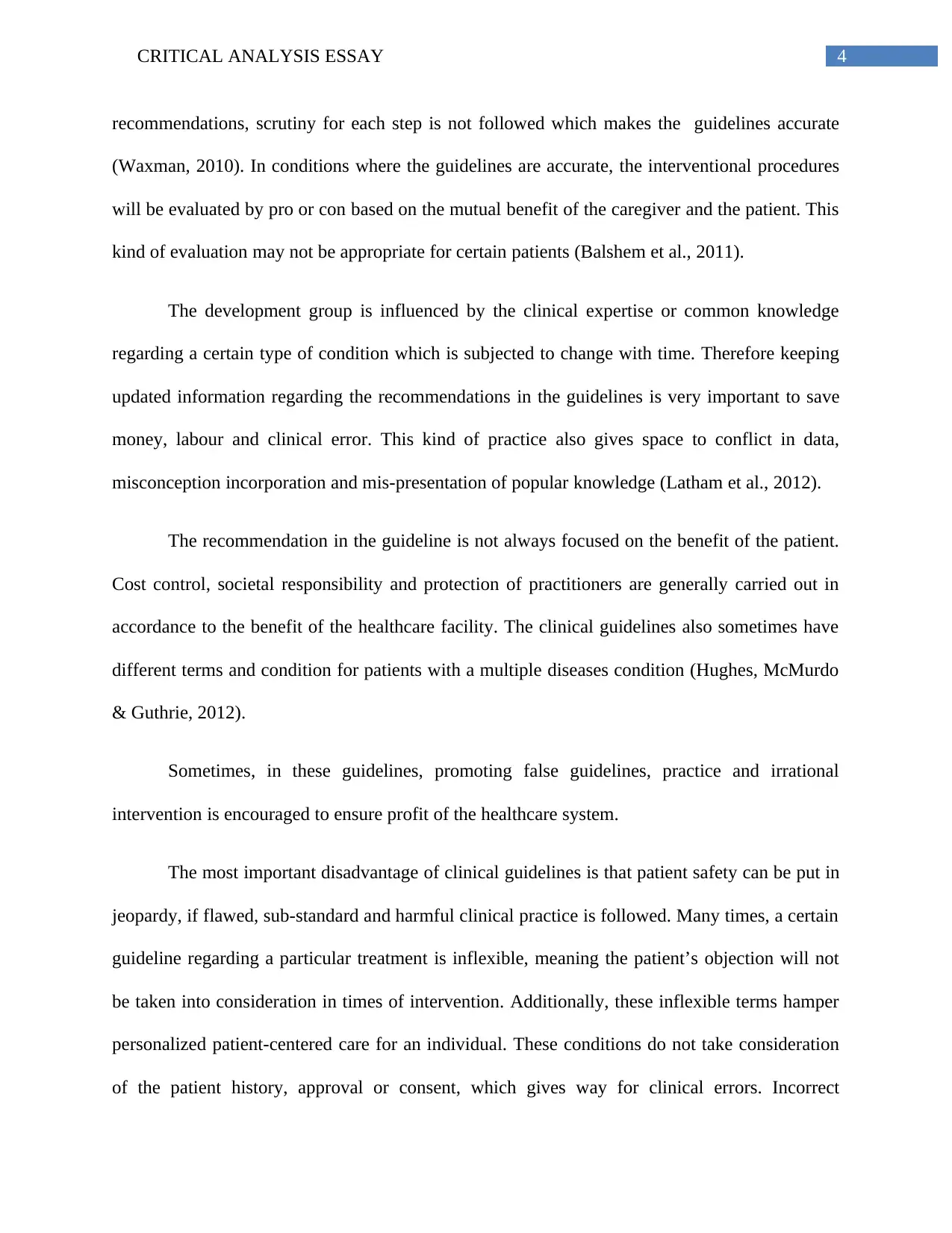
4CRITICAL ANALYSIS ESSAY
recommendations, scrutiny for each step is not followed which makes the guidelines accurate
(Waxman, 2010). In conditions where the guidelines are accurate, the interventional procedures
will be evaluated by pro or con based on the mutual benefit of the caregiver and the patient. This
kind of evaluation may not be appropriate for certain patients (Balshem et al., 2011).
The development group is influenced by the clinical expertise or common knowledge
regarding a certain type of condition which is subjected to change with time. Therefore keeping
updated information regarding the recommendations in the guidelines is very important to save
money, labour and clinical error. This kind of practice also gives space to conflict in data,
misconception incorporation and mis-presentation of popular knowledge (Latham et al., 2012).
The recommendation in the guideline is not always focused on the benefit of the patient.
Cost control, societal responsibility and protection of practitioners are generally carried out in
accordance to the benefit of the healthcare facility. The clinical guidelines also sometimes have
different terms and condition for patients with a multiple diseases condition (Hughes, McMurdo
& Guthrie, 2012).
Sometimes, in these guidelines, promoting false guidelines, practice and irrational
intervention is encouraged to ensure profit of the healthcare system.
The most important disadvantage of clinical guidelines is that patient safety can be put in
jeopardy, if flawed, sub-standard and harmful clinical practice is followed. Many times, a certain
guideline regarding a particular treatment is inflexible, meaning the patient’s objection will not
be taken into consideration in times of intervention. Additionally, these inflexible terms hamper
personalized patient-centered care for an individual. These conditions do not take consideration
of the patient history, approval or consent, which gives way for clinical errors. Incorrect
recommendations, scrutiny for each step is not followed which makes the guidelines accurate
(Waxman, 2010). In conditions where the guidelines are accurate, the interventional procedures
will be evaluated by pro or con based on the mutual benefit of the caregiver and the patient. This
kind of evaluation may not be appropriate for certain patients (Balshem et al., 2011).
The development group is influenced by the clinical expertise or common knowledge
regarding a certain type of condition which is subjected to change with time. Therefore keeping
updated information regarding the recommendations in the guidelines is very important to save
money, labour and clinical error. This kind of practice also gives space to conflict in data,
misconception incorporation and mis-presentation of popular knowledge (Latham et al., 2012).
The recommendation in the guideline is not always focused on the benefit of the patient.
Cost control, societal responsibility and protection of practitioners are generally carried out in
accordance to the benefit of the healthcare facility. The clinical guidelines also sometimes have
different terms and condition for patients with a multiple diseases condition (Hughes, McMurdo
& Guthrie, 2012).
Sometimes, in these guidelines, promoting false guidelines, practice and irrational
intervention is encouraged to ensure profit of the healthcare system.
The most important disadvantage of clinical guidelines is that patient safety can be put in
jeopardy, if flawed, sub-standard and harmful clinical practice is followed. Many times, a certain
guideline regarding a particular treatment is inflexible, meaning the patient’s objection will not
be taken into consideration in times of intervention. Additionally, these inflexible terms hamper
personalized patient-centered care for an individual. These conditions do not take consideration
of the patient history, approval or consent, which gives way for clinical errors. Incorrect
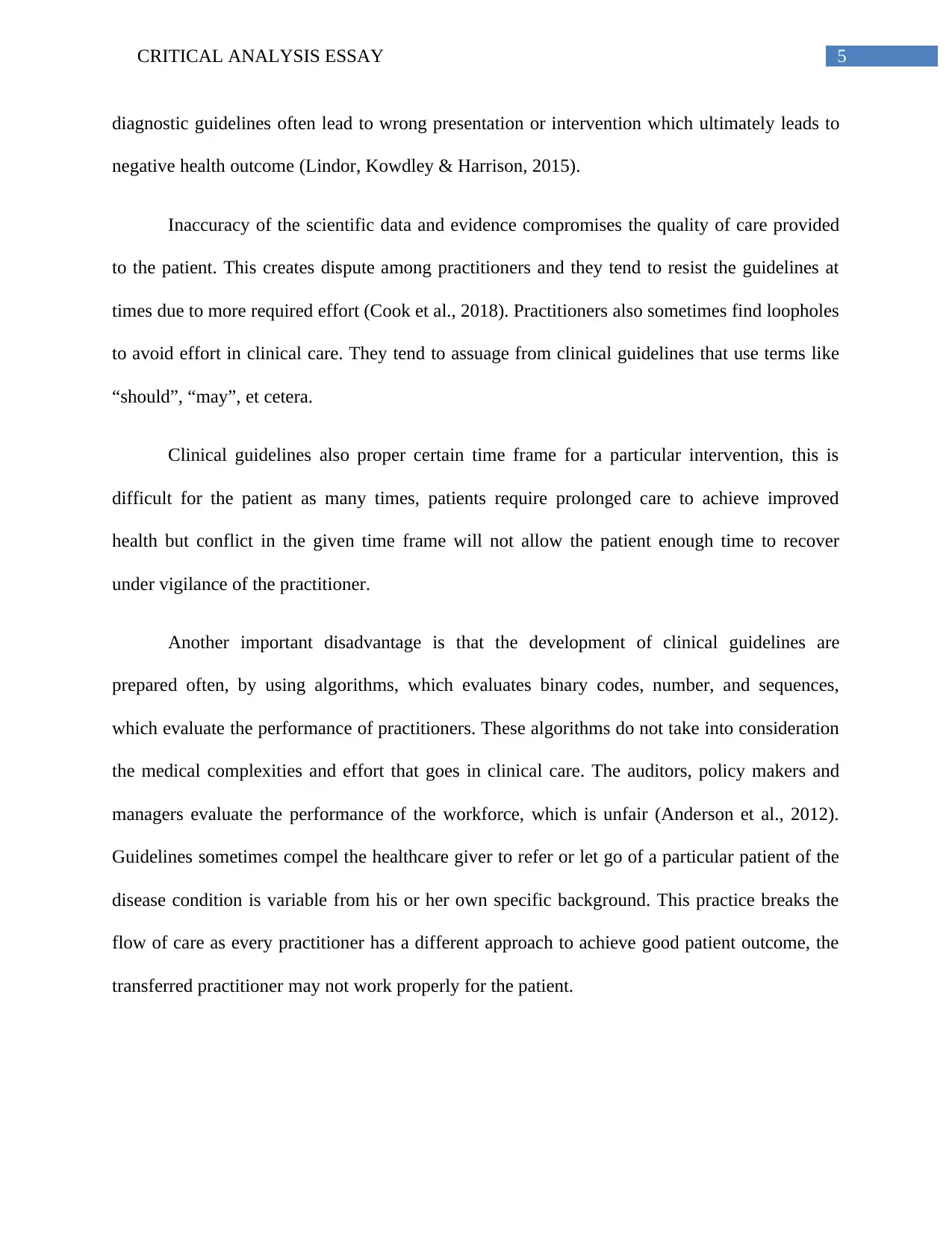
5CRITICAL ANALYSIS ESSAY
diagnostic guidelines often lead to wrong presentation or intervention which ultimately leads to
negative health outcome (Lindor, Kowdley & Harrison, 2015).
Inaccuracy of the scientific data and evidence compromises the quality of care provided
to the patient. This creates dispute among practitioners and they tend to resist the guidelines at
times due to more required effort (Cook et al., 2018). Practitioners also sometimes find loopholes
to avoid effort in clinical care. They tend to assuage from clinical guidelines that use terms like
“should”, “may”, et cetera.
Clinical guidelines also proper certain time frame for a particular intervention, this is
difficult for the patient as many times, patients require prolonged care to achieve improved
health but conflict in the given time frame will not allow the patient enough time to recover
under vigilance of the practitioner.
Another important disadvantage is that the development of clinical guidelines are
prepared often, by using algorithms, which evaluates binary codes, number, and sequences,
which evaluate the performance of practitioners. These algorithms do not take into consideration
the medical complexities and effort that goes in clinical care. The auditors, policy makers and
managers evaluate the performance of the workforce, which is unfair (Anderson et al., 2012).
Guidelines sometimes compel the healthcare giver to refer or let go of a particular patient of the
disease condition is variable from his or her own specific background. This practice breaks the
flow of care as every practitioner has a different approach to achieve good patient outcome, the
transferred practitioner may not work properly for the patient.
diagnostic guidelines often lead to wrong presentation or intervention which ultimately leads to
negative health outcome (Lindor, Kowdley & Harrison, 2015).
Inaccuracy of the scientific data and evidence compromises the quality of care provided
to the patient. This creates dispute among practitioners and they tend to resist the guidelines at
times due to more required effort (Cook et al., 2018). Practitioners also sometimes find loopholes
to avoid effort in clinical care. They tend to assuage from clinical guidelines that use terms like
“should”, “may”, et cetera.
Clinical guidelines also proper certain time frame for a particular intervention, this is
difficult for the patient as many times, patients require prolonged care to achieve improved
health but conflict in the given time frame will not allow the patient enough time to recover
under vigilance of the practitioner.
Another important disadvantage is that the development of clinical guidelines are
prepared often, by using algorithms, which evaluates binary codes, number, and sequences,
which evaluate the performance of practitioners. These algorithms do not take into consideration
the medical complexities and effort that goes in clinical care. The auditors, policy makers and
managers evaluate the performance of the workforce, which is unfair (Anderson et al., 2012).
Guidelines sometimes compel the healthcare giver to refer or let go of a particular patient of the
disease condition is variable from his or her own specific background. This practice breaks the
flow of care as every practitioner has a different approach to achieve good patient outcome, the
transferred practitioner may not work properly for the patient.
⊘ This is a preview!⊘
Do you want full access?
Subscribe today to unlock all pages.

Trusted by 1+ million students worldwide
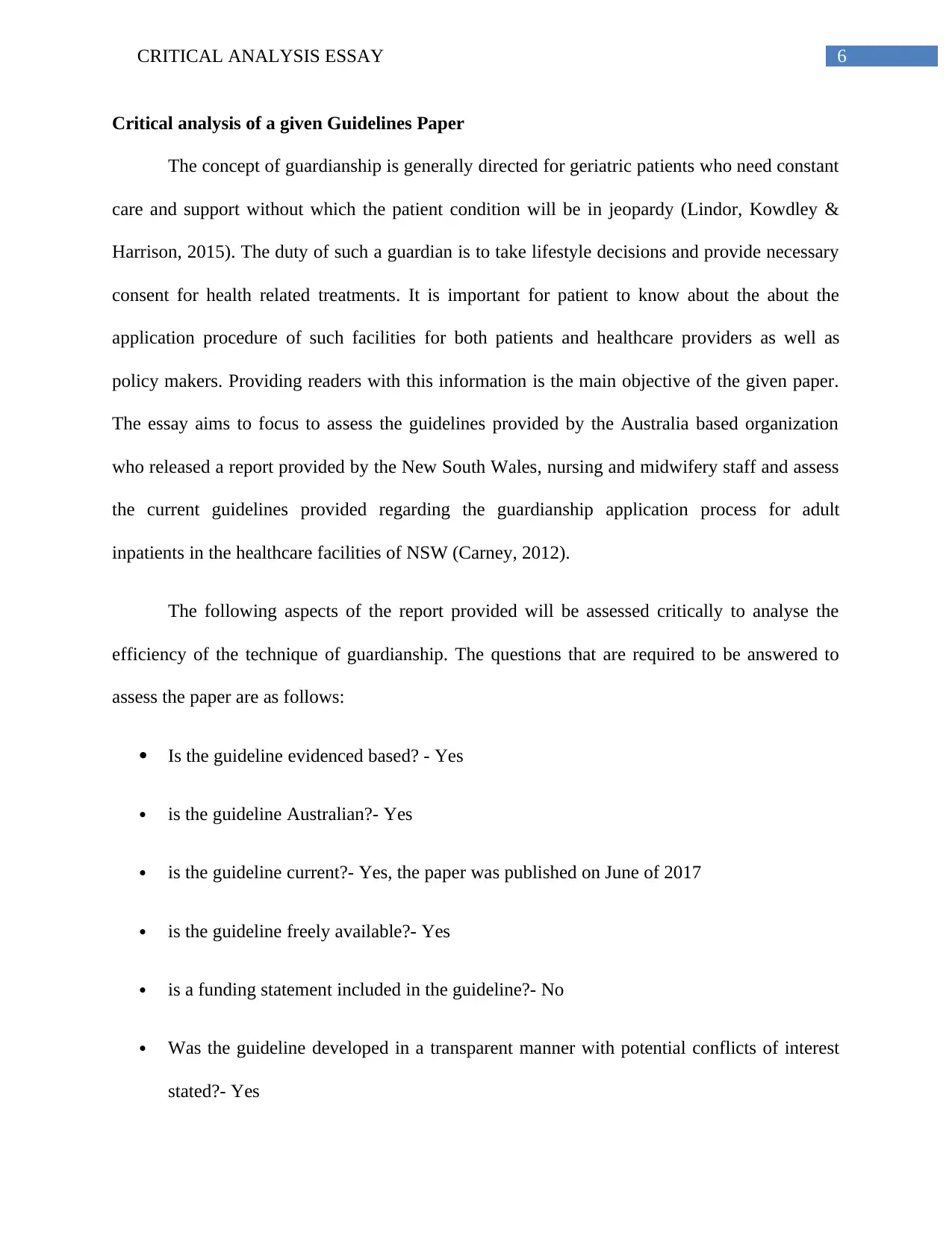
6CRITICAL ANALYSIS ESSAY
Critical analysis of a given Guidelines Paper
The concept of guardianship is generally directed for geriatric patients who need constant
care and support without which the patient condition will be in jeopardy (Lindor, Kowdley &
Harrison, 2015). The duty of such a guardian is to take lifestyle decisions and provide necessary
consent for health related treatments. It is important for patient to know about the about the
application procedure of such facilities for both patients and healthcare providers as well as
policy makers. Providing readers with this information is the main objective of the given paper.
The essay aims to focus to assess the guidelines provided by the Australia based organization
who released a report provided by the New South Wales, nursing and midwifery staff and assess
the current guidelines provided regarding the guardianship application process for adult
inpatients in the healthcare facilities of NSW (Carney, 2012).
The following aspects of the report provided will be assessed critically to analyse the
efficiency of the technique of guardianship. The questions that are required to be answered to
assess the paper are as follows:
Is the guideline evidenced based? - Yes
is the guideline Australian?- Yes
is the guideline current?- Yes, the paper was published on June of 2017
is the guideline freely available?- Yes
is a funding statement included in the guideline?- No
Was the guideline developed in a transparent manner with potential conflicts of interest
stated?- Yes
Critical analysis of a given Guidelines Paper
The concept of guardianship is generally directed for geriatric patients who need constant
care and support without which the patient condition will be in jeopardy (Lindor, Kowdley &
Harrison, 2015). The duty of such a guardian is to take lifestyle decisions and provide necessary
consent for health related treatments. It is important for patient to know about the about the
application procedure of such facilities for both patients and healthcare providers as well as
policy makers. Providing readers with this information is the main objective of the given paper.
The essay aims to focus to assess the guidelines provided by the Australia based organization
who released a report provided by the New South Wales, nursing and midwifery staff and assess
the current guidelines provided regarding the guardianship application process for adult
inpatients in the healthcare facilities of NSW (Carney, 2012).
The following aspects of the report provided will be assessed critically to analyse the
efficiency of the technique of guardianship. The questions that are required to be answered to
assess the paper are as follows:
Is the guideline evidenced based? - Yes
is the guideline Australian?- Yes
is the guideline current?- Yes, the paper was published on June of 2017
is the guideline freely available?- Yes
is a funding statement included in the guideline?- No
Was the guideline developed in a transparent manner with potential conflicts of interest
stated?- Yes
Paraphrase This Document
Need a fresh take? Get an instant paraphrase of this document with our AI Paraphraser
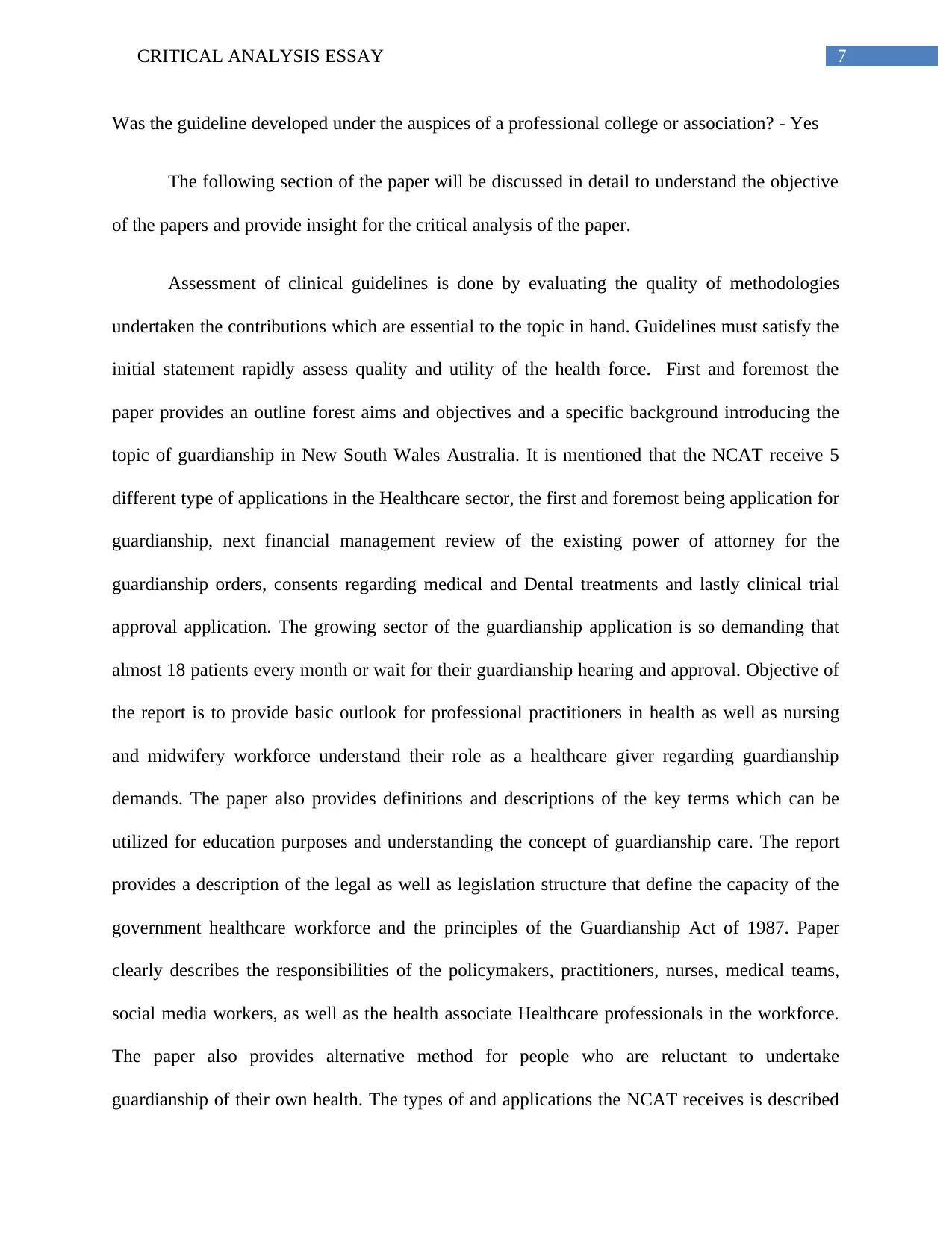
7CRITICAL ANALYSIS ESSAY
Was the guideline developed under the auspices of a professional college or association? - Yes
The following section of the paper will be discussed in detail to understand the objective
of the papers and provide insight for the critical analysis of the paper.
Assessment of clinical guidelines is done by evaluating the quality of methodologies
undertaken the contributions which are essential to the topic in hand. Guidelines must satisfy the
initial statement rapidly assess quality and utility of the health force. First and foremost the
paper provides an outline forest aims and objectives and a specific background introducing the
topic of guardianship in New South Wales Australia. It is mentioned that the NCAT receive 5
different type of applications in the Healthcare sector, the first and foremost being application for
guardianship, next financial management review of the existing power of attorney for the
guardianship orders, consents regarding medical and Dental treatments and lastly clinical trial
approval application. The growing sector of the guardianship application is so demanding that
almost 18 patients every month or wait for their guardianship hearing and approval. Objective of
the report is to provide basic outlook for professional practitioners in health as well as nursing
and midwifery workforce understand their role as a healthcare giver regarding guardianship
demands. The paper also provides definitions and descriptions of the key terms which can be
utilized for education purposes and understanding the concept of guardianship care. The report
provides a description of the legal as well as legislation structure that define the capacity of the
government healthcare workforce and the principles of the Guardianship Act of 1987. Paper
clearly describes the responsibilities of the policymakers, practitioners, nurses, medical teams,
social media workers, as well as the health associate Healthcare professionals in the workforce.
The paper also provides alternative method for people who are reluctant to undertake
guardianship of their own health. The types of and applications the NCAT receives is described
Was the guideline developed under the auspices of a professional college or association? - Yes
The following section of the paper will be discussed in detail to understand the objective
of the papers and provide insight for the critical analysis of the paper.
Assessment of clinical guidelines is done by evaluating the quality of methodologies
undertaken the contributions which are essential to the topic in hand. Guidelines must satisfy the
initial statement rapidly assess quality and utility of the health force. First and foremost the
paper provides an outline forest aims and objectives and a specific background introducing the
topic of guardianship in New South Wales Australia. It is mentioned that the NCAT receive 5
different type of applications in the Healthcare sector, the first and foremost being application for
guardianship, next financial management review of the existing power of attorney for the
guardianship orders, consents regarding medical and Dental treatments and lastly clinical trial
approval application. The growing sector of the guardianship application is so demanding that
almost 18 patients every month or wait for their guardianship hearing and approval. Objective of
the report is to provide basic outlook for professional practitioners in health as well as nursing
and midwifery workforce understand their role as a healthcare giver regarding guardianship
demands. The paper also provides definitions and descriptions of the key terms which can be
utilized for education purposes and understanding the concept of guardianship care. The report
provides a description of the legal as well as legislation structure that define the capacity of the
government healthcare workforce and the principles of the Guardianship Act of 1987. Paper
clearly describes the responsibilities of the policymakers, practitioners, nurses, medical teams,
social media workers, as well as the health associate Healthcare professionals in the workforce.
The paper also provides alternative method for people who are reluctant to undertake
guardianship of their own health. The types of and applications the NCAT receives is described
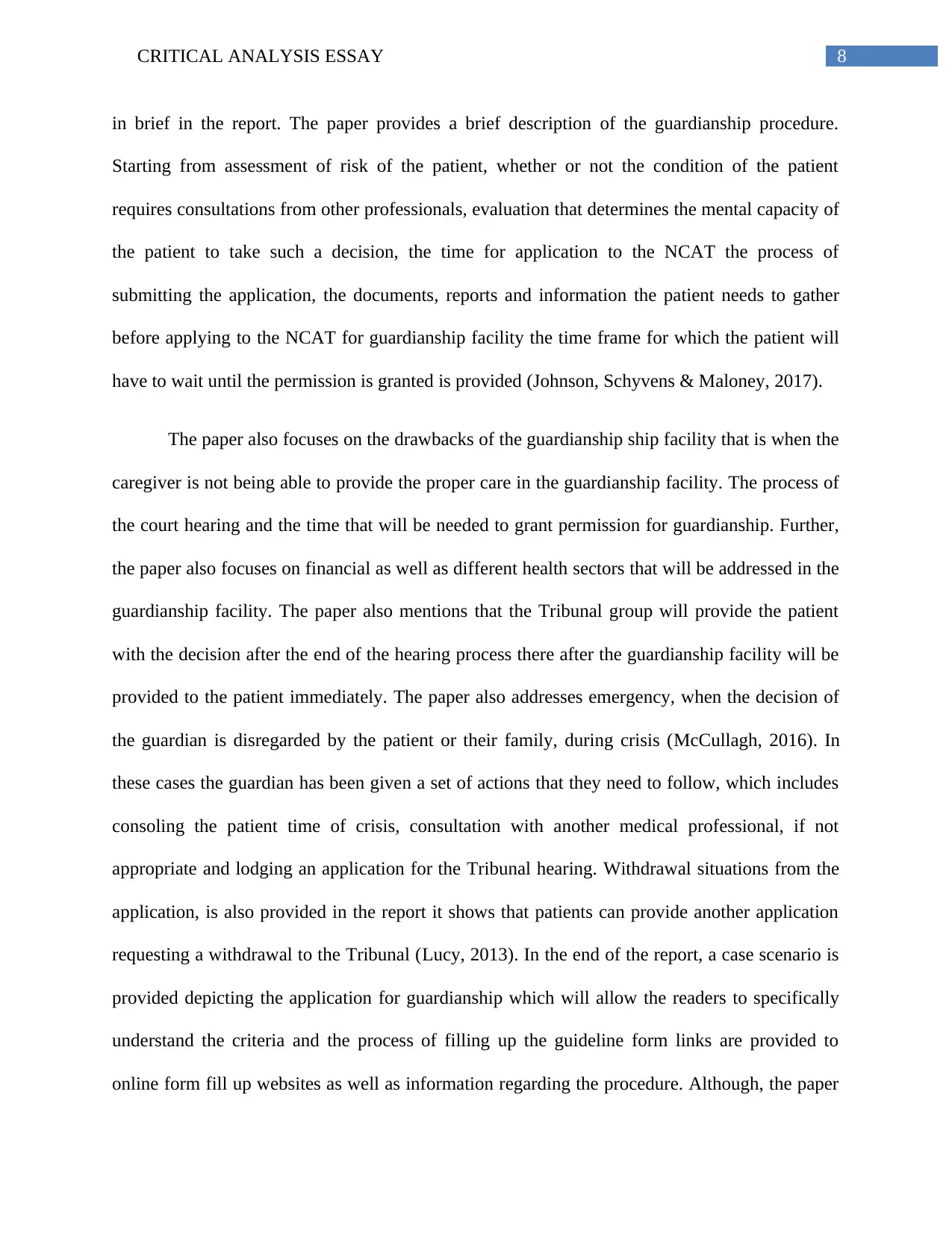
8CRITICAL ANALYSIS ESSAY
in brief in the report. The paper provides a brief description of the guardianship procedure.
Starting from assessment of risk of the patient, whether or not the condition of the patient
requires consultations from other professionals, evaluation that determines the mental capacity of
the patient to take such a decision, the time for application to the NCAT the process of
submitting the application, the documents, reports and information the patient needs to gather
before applying to the NCAT for guardianship facility the time frame for which the patient will
have to wait until the permission is granted is provided (Johnson, Schyvens & Maloney, 2017).
The paper also focuses on the drawbacks of the guardianship ship facility that is when the
caregiver is not being able to provide the proper care in the guardianship facility. The process of
the court hearing and the time that will be needed to grant permission for guardianship. Further,
the paper also focuses on financial as well as different health sectors that will be addressed in the
guardianship facility. The paper also mentions that the Tribunal group will provide the patient
with the decision after the end of the hearing process there after the guardianship facility will be
provided to the patient immediately. The paper also addresses emergency, when the decision of
the guardian is disregarded by the patient or their family, during crisis (McCullagh, 2016). In
these cases the guardian has been given a set of actions that they need to follow, which includes
consoling the patient time of crisis, consultation with another medical professional, if not
appropriate and lodging an application for the Tribunal hearing. Withdrawal situations from the
application, is also provided in the report it shows that patients can provide another application
requesting a withdrawal to the Tribunal (Lucy, 2013). In the end of the report, a case scenario is
provided depicting the application for guardianship which will allow the readers to specifically
understand the criteria and the process of filling up the guideline form links are provided to
online form fill up websites as well as information regarding the procedure. Although, the paper
in brief in the report. The paper provides a brief description of the guardianship procedure.
Starting from assessment of risk of the patient, whether or not the condition of the patient
requires consultations from other professionals, evaluation that determines the mental capacity of
the patient to take such a decision, the time for application to the NCAT the process of
submitting the application, the documents, reports and information the patient needs to gather
before applying to the NCAT for guardianship facility the time frame for which the patient will
have to wait until the permission is granted is provided (Johnson, Schyvens & Maloney, 2017).
The paper also focuses on the drawbacks of the guardianship ship facility that is when the
caregiver is not being able to provide the proper care in the guardianship facility. The process of
the court hearing and the time that will be needed to grant permission for guardianship. Further,
the paper also focuses on financial as well as different health sectors that will be addressed in the
guardianship facility. The paper also mentions that the Tribunal group will provide the patient
with the decision after the end of the hearing process there after the guardianship facility will be
provided to the patient immediately. The paper also addresses emergency, when the decision of
the guardian is disregarded by the patient or their family, during crisis (McCullagh, 2016). In
these cases the guardian has been given a set of actions that they need to follow, which includes
consoling the patient time of crisis, consultation with another medical professional, if not
appropriate and lodging an application for the Tribunal hearing. Withdrawal situations from the
application, is also provided in the report it shows that patients can provide another application
requesting a withdrawal to the Tribunal (Lucy, 2013). In the end of the report, a case scenario is
provided depicting the application for guardianship which will allow the readers to specifically
understand the criteria and the process of filling up the guideline form links are provided to
online form fill up websites as well as information regarding the procedure. Although, the paper
⊘ This is a preview!⊘
Do you want full access?
Subscribe today to unlock all pages.

Trusted by 1+ million students worldwide
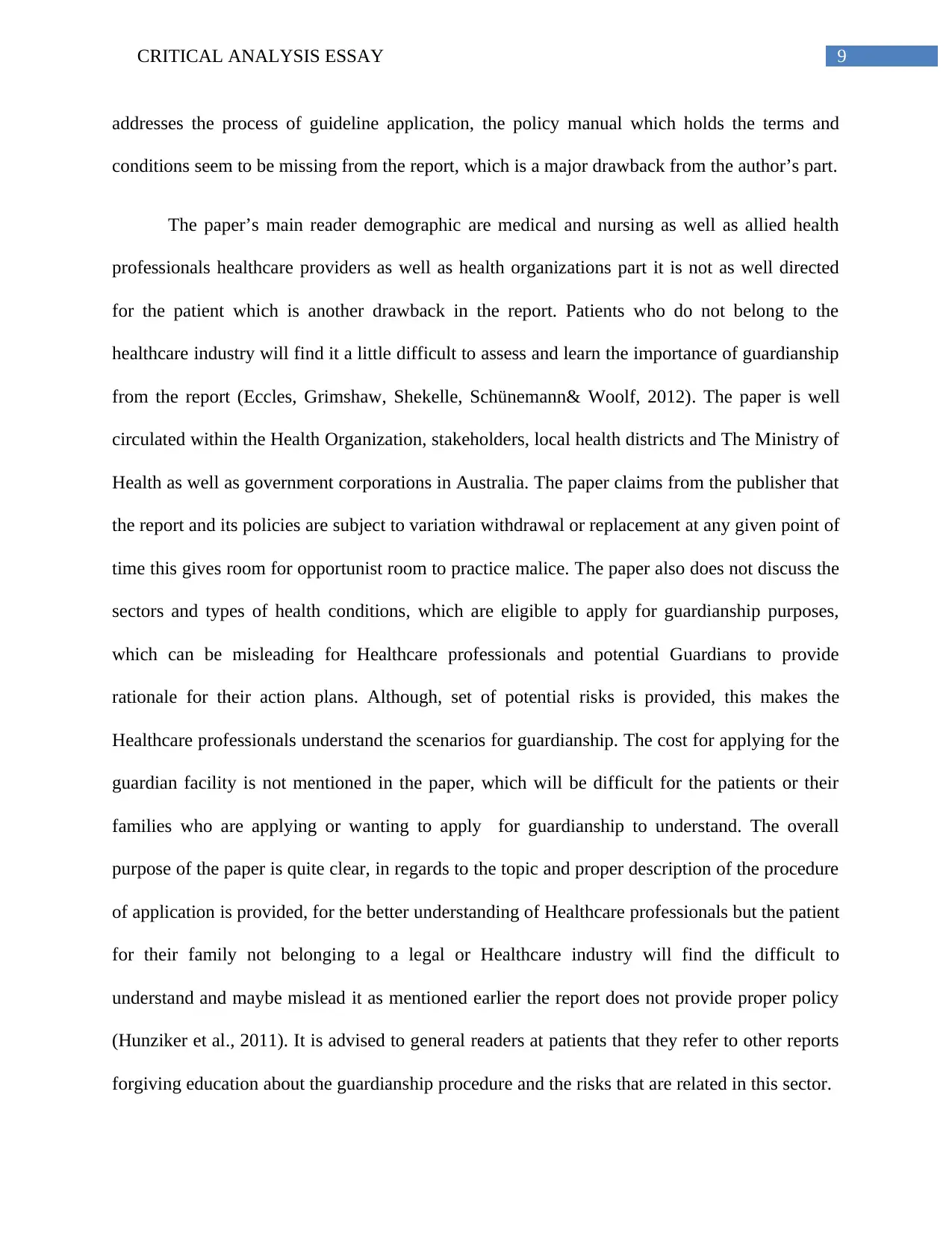
9CRITICAL ANALYSIS ESSAY
addresses the process of guideline application, the policy manual which holds the terms and
conditions seem to be missing from the report, which is a major drawback from the author’s part.
The paper’s main reader demographic are medical and nursing as well as allied health
professionals healthcare providers as well as health organizations part it is not as well directed
for the patient which is another drawback in the report. Patients who do not belong to the
healthcare industry will find it a little difficult to assess and learn the importance of guardianship
from the report (Eccles, Grimshaw, Shekelle, Schünemann& Woolf, 2012). The paper is well
circulated within the Health Organization, stakeholders, local health districts and The Ministry of
Health as well as government corporations in Australia. The paper claims from the publisher that
the report and its policies are subject to variation withdrawal or replacement at any given point of
time this gives room for opportunist room to practice malice. The paper also does not discuss the
sectors and types of health conditions, which are eligible to apply for guardianship purposes,
which can be misleading for Healthcare professionals and potential Guardians to provide
rationale for their action plans. Although, set of potential risks is provided, this makes the
Healthcare professionals understand the scenarios for guardianship. The cost for applying for the
guardian facility is not mentioned in the paper, which will be difficult for the patients or their
families who are applying or wanting to apply for guardianship to understand. The overall
purpose of the paper is quite clear, in regards to the topic and proper description of the procedure
of application is provided, for the better understanding of Healthcare professionals but the patient
for their family not belonging to a legal or Healthcare industry will find the difficult to
understand and maybe mislead it as mentioned earlier the report does not provide proper policy
(Hunziker et al., 2011). It is advised to general readers at patients that they refer to other reports
forgiving education about the guardianship procedure and the risks that are related in this sector.
addresses the process of guideline application, the policy manual which holds the terms and
conditions seem to be missing from the report, which is a major drawback from the author’s part.
The paper’s main reader demographic are medical and nursing as well as allied health
professionals healthcare providers as well as health organizations part it is not as well directed
for the patient which is another drawback in the report. Patients who do not belong to the
healthcare industry will find it a little difficult to assess and learn the importance of guardianship
from the report (Eccles, Grimshaw, Shekelle, Schünemann& Woolf, 2012). The paper is well
circulated within the Health Organization, stakeholders, local health districts and The Ministry of
Health as well as government corporations in Australia. The paper claims from the publisher that
the report and its policies are subject to variation withdrawal or replacement at any given point of
time this gives room for opportunist room to practice malice. The paper also does not discuss the
sectors and types of health conditions, which are eligible to apply for guardianship purposes,
which can be misleading for Healthcare professionals and potential Guardians to provide
rationale for their action plans. Although, set of potential risks is provided, this makes the
Healthcare professionals understand the scenarios for guardianship. The cost for applying for the
guardian facility is not mentioned in the paper, which will be difficult for the patients or their
families who are applying or wanting to apply for guardianship to understand. The overall
purpose of the paper is quite clear, in regards to the topic and proper description of the procedure
of application is provided, for the better understanding of Healthcare professionals but the patient
for their family not belonging to a legal or Healthcare industry will find the difficult to
understand and maybe mislead it as mentioned earlier the report does not provide proper policy
(Hunziker et al., 2011). It is advised to general readers at patients that they refer to other reports
forgiving education about the guardianship procedure and the risks that are related in this sector.
Paraphrase This Document
Need a fresh take? Get an instant paraphrase of this document with our AI Paraphraser
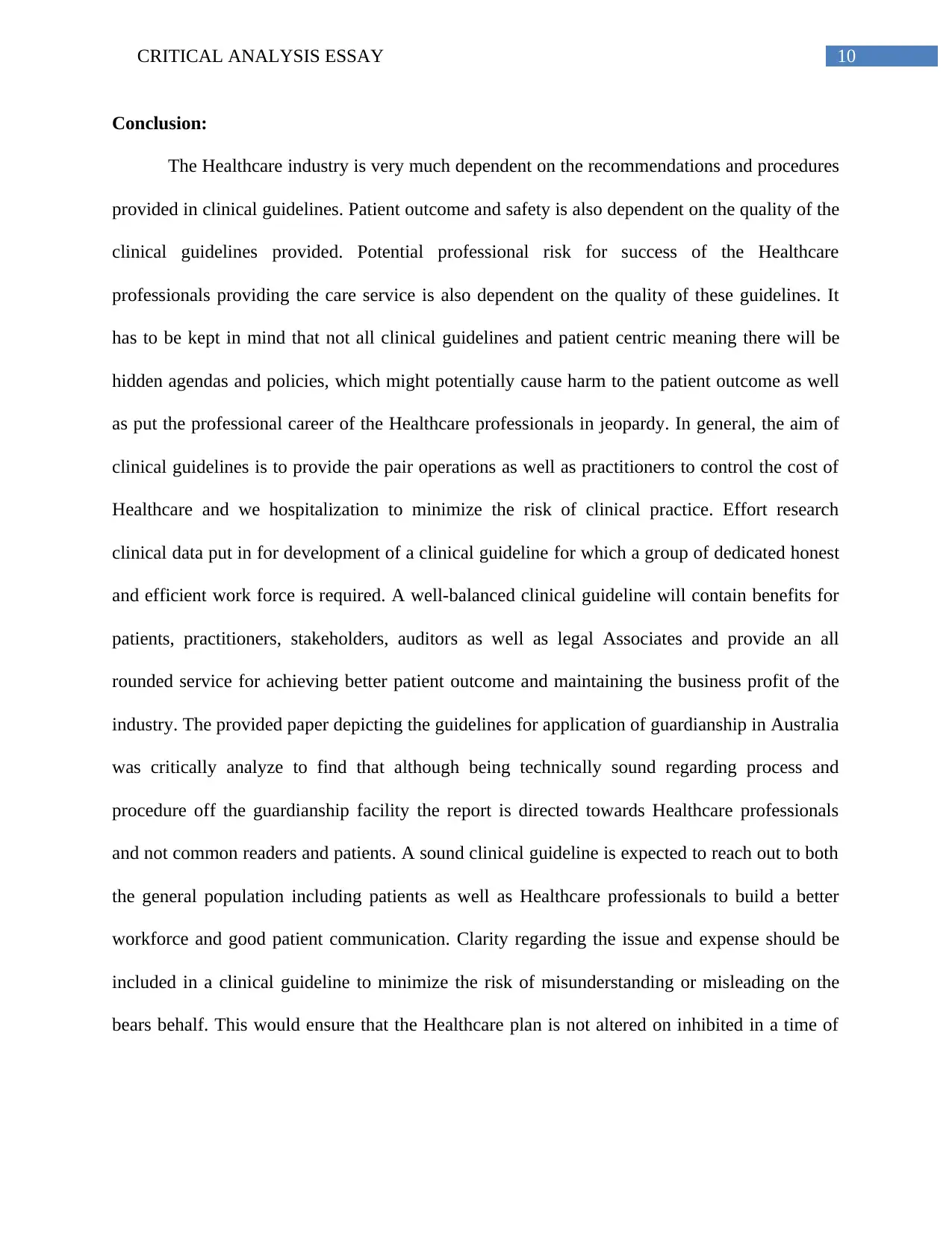
10CRITICAL ANALYSIS ESSAY
Conclusion:
The Healthcare industry is very much dependent on the recommendations and procedures
provided in clinical guidelines. Patient outcome and safety is also dependent on the quality of the
clinical guidelines provided. Potential professional risk for success of the Healthcare
professionals providing the care service is also dependent on the quality of these guidelines. It
has to be kept in mind that not all clinical guidelines and patient centric meaning there will be
hidden agendas and policies, which might potentially cause harm to the patient outcome as well
as put the professional career of the Healthcare professionals in jeopardy. In general, the aim of
clinical guidelines is to provide the pair operations as well as practitioners to control the cost of
Healthcare and we hospitalization to minimize the risk of clinical practice. Effort research
clinical data put in for development of a clinical guideline for which a group of dedicated honest
and efficient work force is required. A well-balanced clinical guideline will contain benefits for
patients, practitioners, stakeholders, auditors as well as legal Associates and provide an all
rounded service for achieving better patient outcome and maintaining the business profit of the
industry. The provided paper depicting the guidelines for application of guardianship in Australia
was critically analyze to find that although being technically sound regarding process and
procedure off the guardianship facility the report is directed towards Healthcare professionals
and not common readers and patients. A sound clinical guideline is expected to reach out to both
the general population including patients as well as Healthcare professionals to build a better
workforce and good patient communication. Clarity regarding the issue and expense should be
included in a clinical guideline to minimize the risk of misunderstanding or misleading on the
bears behalf. This would ensure that the Healthcare plan is not altered on inhibited in a time of
Conclusion:
The Healthcare industry is very much dependent on the recommendations and procedures
provided in clinical guidelines. Patient outcome and safety is also dependent on the quality of the
clinical guidelines provided. Potential professional risk for success of the Healthcare
professionals providing the care service is also dependent on the quality of these guidelines. It
has to be kept in mind that not all clinical guidelines and patient centric meaning there will be
hidden agendas and policies, which might potentially cause harm to the patient outcome as well
as put the professional career of the Healthcare professionals in jeopardy. In general, the aim of
clinical guidelines is to provide the pair operations as well as practitioners to control the cost of
Healthcare and we hospitalization to minimize the risk of clinical practice. Effort research
clinical data put in for development of a clinical guideline for which a group of dedicated honest
and efficient work force is required. A well-balanced clinical guideline will contain benefits for
patients, practitioners, stakeholders, auditors as well as legal Associates and provide an all
rounded service for achieving better patient outcome and maintaining the business profit of the
industry. The provided paper depicting the guidelines for application of guardianship in Australia
was critically analyze to find that although being technically sound regarding process and
procedure off the guardianship facility the report is directed towards Healthcare professionals
and not common readers and patients. A sound clinical guideline is expected to reach out to both
the general population including patients as well as Healthcare professionals to build a better
workforce and good patient communication. Clarity regarding the issue and expense should be
included in a clinical guideline to minimize the risk of misunderstanding or misleading on the
bears behalf. This would ensure that the Healthcare plan is not altered on inhibited in a time of
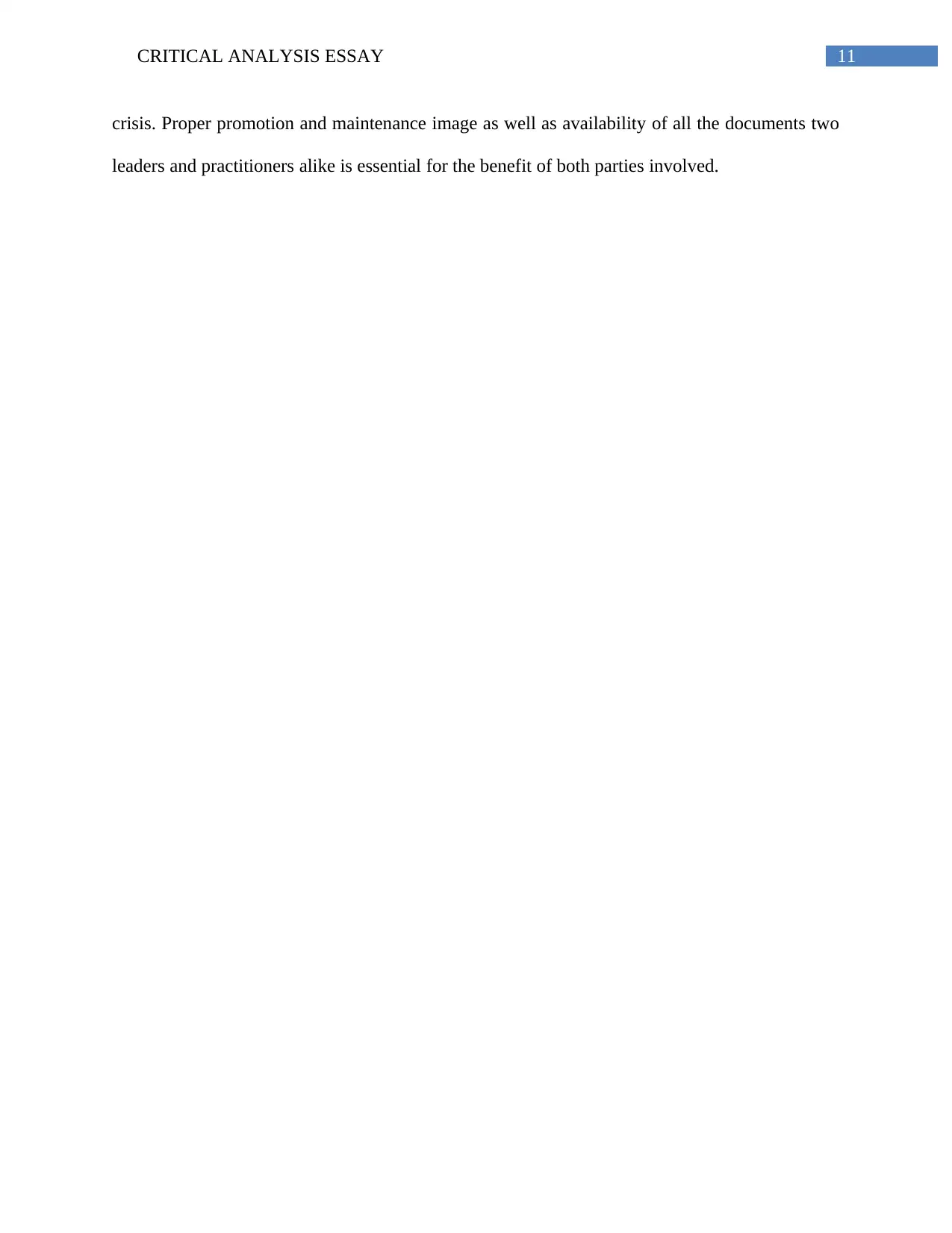
11CRITICAL ANALYSIS ESSAY
crisis. Proper promotion and maintenance image as well as availability of all the documents two
leaders and practitioners alike is essential for the benefit of both parties involved.
crisis. Proper promotion and maintenance image as well as availability of all the documents two
leaders and practitioners alike is essential for the benefit of both parties involved.
⊘ This is a preview!⊘
Do you want full access?
Subscribe today to unlock all pages.

Trusted by 1+ million students worldwide
1 out of 16
Related Documents
Your All-in-One AI-Powered Toolkit for Academic Success.
+13062052269
info@desklib.com
Available 24*7 on WhatsApp / Email
![[object Object]](/_next/static/media/star-bottom.7253800d.svg)
Unlock your academic potential
Copyright © 2020–2025 A2Z Services. All Rights Reserved. Developed and managed by ZUCOL.




